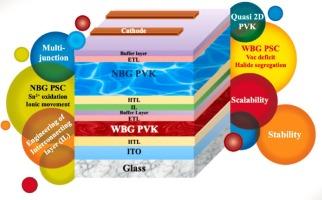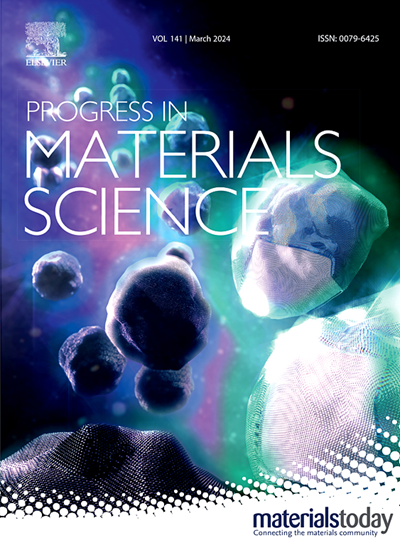Recent progress in all-perovskite tandem solar cells and modules: redefining limits
IF 40
1区 材料科学
Q1 MATERIALS SCIENCE, MULTIDISCIPLINARY
引用次数: 0
Abstract
All-perovskite tandem solar cells (APTSCs) are garnering considerable attention as efficiencies of single-junction solar cells approach the Shockley–Queisser limit. The operation of APTSCs relies on the coordinated performance of the top and bottom cells, which together offer an optimal balance between cost-effectiveness and power output. Despite their promising architecture, the performance of APTSCs remains constrained by several intrinsic and extrinsic factors such as grain boundaries, bulk and interfacial defects, along with crystallization challenges. Nonetheless, the implementation of mitigation strategies enables effective resolution of these challenges, thereby enhancing the adaptability and performance potential of APTSCs. This review systematically examines the individual components, besides whole architectures of 2T and 4T of APTSCs, along with their recent advancements. It highlights a range of performance enhancement strategies, including the optimization of interconnecting layers, the integration of light-trapping mechanisms, and the incorporation of quasi-2D perovskites. The discussion further extends to the fabrication of large-area devices, a critical step toward commercial scalability. Finally, the review outlines current challenges and proposes future research directions aimed at improving efficiency, stability, and manufacturability. This review outlines a comprehensive roadmap integrating innovative design strategies, advanced simulation methodologies—including finite element method and density functional theory—and state-of-the-art characterization techniques to accelerate the development of next-generation, high-performance all-perovskite tandem solar cells.

全钙钛矿串联太阳能电池和组件的最新进展:重新定义极限
随着单结太阳能电池的效率接近Shockley-Queisser极限,全钙钛矿串联太阳能电池(aptsc)正受到越来越多的关注。APTSCs的运行依赖于顶部和底部电池的协调性能,它们共同提供了成本效益和功率输出之间的最佳平衡。尽管APTSCs的结构很有前途,但其性能仍然受到一些内在和外在因素的限制,如晶界、体积和界面缺陷,以及结晶挑战。尽管如此,实施缓解战略能够有效解决这些挑战,从而增强aptsc的适应性和性能潜力。本文系统地考察了aptsc的各个组成部分,以及2T和4T的整体架构,以及它们的最新进展。它强调了一系列性能增强策略,包括互连层的优化、光捕获机制的集成以及准二维钙钛矿的结合。讨论进一步扩展到大面积器件的制造,这是实现商业可扩展性的关键一步。最后,综述概述了当前面临的挑战,并提出了未来的研究方向,旨在提高效率,稳定性和可制造性。本文概述了综合创新设计策略、先进模拟方法(包括有限元法和密度泛函数理论)和最先进的表征技术的全面路线图,以加速下一代高性能全钙钛矿串联太阳能电池的开发。
本文章由计算机程序翻译,如有差异,请以英文原文为准。
求助全文
约1分钟内获得全文
求助全文
来源期刊

Progress in Materials Science
工程技术-材料科学:综合
CiteScore
59.60
自引率
0.80%
发文量
101
审稿时长
11.4 months
期刊介绍:
Progress in Materials Science is a journal that publishes authoritative and critical reviews of recent advances in the science of materials. The focus of the journal is on the fundamental aspects of materials science, particularly those concerning microstructure and nanostructure and their relationship to properties. Emphasis is also placed on the thermodynamics, kinetics, mechanisms, and modeling of processes within materials, as well as the understanding of material properties in engineering and other applications.
The journal welcomes reviews from authors who are active leaders in the field of materials science and have a strong scientific track record. Materials of interest include metallic, ceramic, polymeric, biological, medical, and composite materials in all forms.
Manuscripts submitted to Progress in Materials Science are generally longer than those found in other research journals. While the focus is on invited reviews, interested authors may submit a proposal for consideration. Non-invited manuscripts are required to be preceded by the submission of a proposal. Authors publishing in Progress in Materials Science have the option to publish their research via subscription or open access. Open access publication requires the author or research funder to meet a publication fee (APC).
Abstracting and indexing services for Progress in Materials Science include Current Contents, Science Citation Index Expanded, Materials Science Citation Index, Chemical Abstracts, Engineering Index, INSPEC, and Scopus.
 求助内容:
求助内容: 应助结果提醒方式:
应助结果提醒方式:


